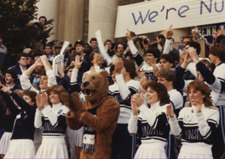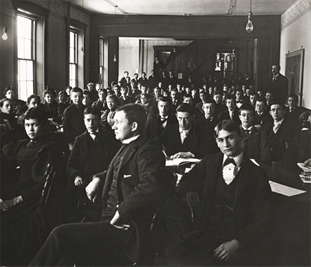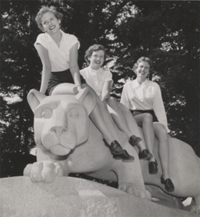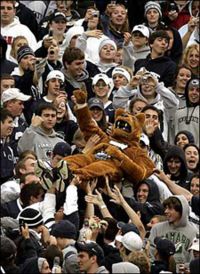Bleeding Blue, White, and Rainbow in State College, PA
An Introduction to Life in Happy Valley

Penn State has never been altogether welcoming for those who are underrepresented with respect to gender identity or sexual orientation, and the strict adherence to and encouragement of the gender binary at Penn State (which turned coed in 1871) serves as an example. However, in spite of the generally heteronormative culture, many lesbian, gay, bisexual, transgender, queer, and allied (LGBTQA) people still yearn to experience life in State College, and those who do are proud to call it home.
The sprawling borough laid out below Mount Nittany is somewhat an oasis amidst the vast green wilderness that can be seen from the highway. The Borough of State College, only a few miles from Exit 162 of Interstate 80, is fondly referred to as Happy Valley and was recently listed as the safest metropolitan area in the United States by CQ Press. [2] People familiar with Central Pennsylvania can affirm that the charm of Happy Valley is intimately associated with the Pennsylvania State University. With nearly 24,000 employees at the University Park campus, Penn State is the largest employer in Central Pennsylvania and the University both relies on and provides for residents of Centre County and the surrounding region. In addition to its significant workforce, Penn State is also one of the largest school systems in the country and draws most of its student body from across the State. In 2009, there were nearly 44,000 undergraduates enrolled at the University Park campus and over 94,000 between all 20 campuses. A map at Penn State Admissions' website shows all 19 physical locations. Nearly 60 percent of undergraduate students enroll at a regional campus but eventually graduate from the University Park campus. Given the enormous number of Penn State employees, students, and alumni who live throughout Pennsylvania and who become acquainted with State College, it is not surprising that the closely knit "town and gown" communities entwined in Happy Valley are burgeoning with Penn State pride.

Athletic events are perhaps the best way to muster Penn State pride. Starting in the first year of college, Penn Staters inevitably venture out to a number of sporting events, and the Football games quickly become a necessary cultural experience - even for those who might initially dislike sporting events. Of course with most mainstream events at Penn State, pre-gaming and other forms of binge drinking are almost required for one to be considered an adequately socialized student. These cultural expectations - Penn State pride, athletics, and alcohol - are likely responsible for Penn State earning the Number 1 party school in the Princeton Review's 2009 survey. Some people may argue that this is owed to other factors, however Penn State also earned 1st place for "packing the stadium" and "lots of beer."[4] It is important to note that this school draws its partying population from all over the largely conservative State of Pennsylvania, which contributes to the borough's social and political tensions. Even Penn State administrators will convey that alcohol is a social lubrication that increases public displays of discrimination or harassment. Several videos documenting such alcohol-lubricated incidents can be seen on the exhibit page titled Closets of a College Town.
Politically speaking, Pennsylvania is often referred to as "two cities separated by Alabama." Considering that the student population at University Park comes from across the conservative State of Pennsylvania, the political and social tensions which frequently develop in State College are not surprising. While many incidents of discrimination and harassment are frequently reported wherever alcohol is consumed - primarily during weekends and sporting events - progressive student groups also contribute to the tension, and modern education does little to prepare bystanders to mentally process the philosophies and civil responsibilities associated with demonstrating, protesting, and rallying. As a result, outspoken conservative or liberal progressives are often viewed too simplistically - as disruptive groups that unnecessarily complain and darken the generally affable atmosphere. Thus, as a liberal oasis in a conservative region, State College is a hotbed of contentious activism where college communities may participate in political and social change, although many people never fully appreciate the complex political movements that occur on a college campus.

Despite the influence of progressive groups, State College has always catered to a large conservative community. Pictures from different eras (left & below) demonstrate the longstanding hetero-normativity that persists at Penn State; whether through athletics, fraternities & sororities, or any number of student groups - most students resist and avidly discourage any deviation from the gender binary. To this end, the Penn State community promulgates the gender binary and hetero-normativity that is often exemplified at sporting events, homecoming week, fraternity & sorority events, and even on everyday paperwork throughout the University. Those who publicly test the binary or hetero-normativity are generally either taken as whimsical comedians or unpopular outcasts, depending on the time, place, and manner.

The Penn State athletics community serves as clear evidence that the University community propagates the gender binary. Over the last 30 years, numerous demonstrations, protests, and rallies at Penn State have drawn attention to discriminating practices in its Athletics Department that have stifled students, affecting all of the Penn State campuses. As demonstrated by its advertising practices, the University supports the conservative majority and perpetuates the expected social standards that include the gender binary. In particular, it would be a blinding error to delineate any historical time line for gender identity or sexual orientation at Penn State without mentioning the former Lady Lions' Basketball Coach, Rene Portland. Hired in 1980, Coach Portland had a long and public history of discriminating against students who swayed from hetero-normativity. In 1986, the Chicago-Sun Times quoted Portland's infamous philosophy: "no-drinking, no-drugs, no-lesbians" on her team. This extended not only to students who practiced homosexuality but also to students who did not fit the gender binary - and some may argue Portland further discriminated against her non-white players. A recent documentary, "Training Rules" (2009), gives the history and reports on how the University avoided confronting the threatening faculty member until school administrators were faced with bad publicity and a legal battle. Ironically, Coach Portland's open discrimination often served as a rallying point which unified student communities and eventually led to institutional reform that encourages a safer learning environment for students.

Despite the threatening environment, Penn State pride seems to overwhelm any adversity. Materializing from unified masses that chant fight songs for the "Blue & White," the undying Penn State pride seems to bring together the entire community to celebrate and support athletic teams. This unique camaraderie yields an impressive sense of pride that is often owned and worn proudly even by those who carry Rainbow flags during campus demonstrations, protests, or rallies for their own underrepresented communities.
Over the last 40 years since Stonewall, Penn State has remained largely unwelcoming to lesbian, gay, bisexual, transgender, queer, and allied (LGBTQA) communities. However, it is clear that institutional progress has been made; Penn State was recently placed among the top 20 in The Advocate College Guide for LGBT Students.[8] Thus, there are now substantial resources for LGBTQA communities at Penn State and in Central Pennsylvania, which ironically may be a direct result of the frequent conservative and discriminatory actions of Penn State students, staff, and faculty.
Exhibit Pages
- Closets of a College Town
- Detailed Timeline of LGBTQA-Specific Events 1969 ~ 2010
- Famous LGBTQA Alums and Locals to Central PA
- Queer Resources of Happy Valley
Touchstone Events Affecting State College, 1969 ~ 2010
- Student Group Abbreviations:
- HOPS - Homophiles of Penn State;
- GSA - Graduate Student Association;
- GSS - Gay Student Services;
- LGBSA - Lesbian, Gay, and Bisexual Student Alliance;
- LGSA - Lesbian and Gay Student Alliance;
- LSA - Lambda Student Alliance;
- oSTEM - Out in Science, Technology, Engineering, and Mathematics;
- STRAIGHT - Students Reinforcing Adherence in General Heterosexual Traditions;
- USG - Undergraduate Student Government;
1970's
- (1971, Apr) USG approves charter for HOPS
- (1971, May) Student Affairs suspends HOPS
- (1971, Jun) HOPS is rechartered by the GSA
- (1971, Sep) Student Affairs reaffirms suspension of HOPS
- (1972, Feb) HOPS files suit against Penn State
- (1973, Jan) Out of court settlement grants charter to HOPS
- (1975, Apr) Gov. Milton Shapp issues Executive Order 1975-5 (Committing his administration to gay rights)
- (1976, May) Resident Assistant Anthony Carozza denied rehire at Penn State
- (1976, Jun) Gov. Milton Shapp proclaims first Pennsylvania Gay Pride Week
- (1976, Jun) Gov. Shapp amends 1975-5 (Creating a Council for Sexual Minorities)
- (1976, Nov) Carozza rehired at Penn State
- (1978, Sep) Gov. Milton Shapp revises Executive Order 1975-5 (Creating a Council on Sexual Minorities)
- (1979, Jun) Gov. Dick Thornburgh offers affirmation for Gay Pride Week
1980's
- (1980, Jun) Joe Paterno hires Rene Portland to Coach Lady Lions Basketball
- (1984, Feb) Gov. Thornburgh issues Executive Order 1984-1 (Affirmative Action Legislation)
- (1984, Apr) HOPS transitions into Off-Campus Gay/Lesbian Switchboard
- (1984) Local gay bar "Chumley's" opens
- (1985, Feb) USG approves Charter for GSS
- (1986, Oct) GSS Transitions into LGSA
- (1986, Jun) Rene Portland says "No drinking, No drugs, No lesbians"
- (1988, Jan) Gov. Robert Casey Amends Executive Order 1984-1 with 1988-1 (Adding sexual orientation)
- (1988, Apr) First Week-Long Pride Celebration at Penn State
- (1988, Apr) Anti-gay posters appear around campus
- (1988, Oct) Campus environment team recommends Committee on LGB Equity
- (1989) Conservative independent newspaper, "The Lionhearted" founded
- (1989, Mar) The Whitehead BITNET/NEWSNET incident
1990's
- (1990, Jun) LGSA files affirmative action complaint against Penn State
- (1990, Dec) LGSA approves addition of "Bisexual" to group name
- (1991, Jan) Committee appointed to review climate experienced by lesbians and gay men
- (1991, May) Penn State revises non-discrimination policy
- (1991, Oct) Commission on Lesbian, Gay, and Bisexual Equity founded
- (1992, Mar) Coalition of LGBT Graduate Students founded
- (1992, Oct) New group "Allies" pledges support to LGBSA
- (1993, Mar) State College Borough adopts fair housing ordinance
- (1993, Aug) Liberal independent newspaper "Voices of Central Pennsylvania" founded
- (1994, Sep) LGBT Support Network formalized
- (1995, Jan) LGBSA mixed about adding "Transgender" to group name
- (1995, Oct) Anti-gay posters advertise "National Going Back Into the Closet Day"
- (1996, Dec) Gov. Thomas Ridge amends Executive Order 1988-1 with 1996-9
- (1996 - 1998?) LGBSA group becomes a more inclusive group - LSA
- (1997, Mar) USG approves charter for STRAIGHT group
- (1998, Aug) LGBTA Resource Room opens in Grange Building
- (1999, Mar) STRAIGHT group to disband for lack of membership interest
2000's
- (2000, Jun) Transgender added to Commission's name (CLGBTE)
- (2001, Jan) LGBTA Student Resource Center comes to Boucke Building
- (2001, Apr) Undertones is founded to provide support for LGBTA minorities
- (2001, Nov) Director hired for LGBTA Student Resource Center
- (2002, May) Gov. Edward Rendell amends Executive Order 1996-9 with 2002-3
- (2003, Mar) First annual "One in Ten Film Festival"
- (2003, May) Student groups merge: LSA and Allies
- (2003, Jul) Gov. Edward Rendell amends Executive Order 2002-3 with 2003-10
- (2005, Oct) USG approves charter for oSTEM group
- (2005, Oct) Student Stonewall Coalition leads grassroots social justice for LGBTQA communities
- (2005, Feb) Kovalchick's letter to the editor
- (2005, Jan) Penn State formalizes domestic partner benefits
- (2005, Oct) Harris vs. Portland, Curley, and Penn State
- (2006, Jan) Allies transitions into SpeakOut, a political action group
- (2006, Jan) Axis is founded as an undergraduate social group
- (2006, Apr) Penn State fines Portland $10,000
- (2006, May) Penn State revises non-discrimination policy
- (2006, Sep) Dickinson law students bring Outlaws group to University Park campus
- (2007, Feb) Harris claim settled
- (2007, Mar) Rene Portland resigns from Penn State
- (2007, Apr) First Pride Week award at Penn State
- (2007, Dec) State College revises anti-discrimination policy
- (2008, Apr) State College Mayor presides over gay commitment ceremony
- (2009, Jul) Sexuality and Gender Studies minor formalized
- (2010, Jan) Club Mezzanine offers Sunday nights to LGBT communities
- (2010, Mar) Gay Fraternity (Delta Lambda Phi) added to Interfraternity Council
References and Sources
- ↑ Adapted from: Anonymous. "A View of Happy Valley from Mount Nittany." Photo. 2006. Retrieved 18 February 2010. http://www.city-data.com/picfilesc/picc24961.php.
- ↑ [1] CQ Press. 2009 Metropolitan Crime Rate Rankings. http://os.cqpress.com/citycrime/2009/MetroCrime2009_Rank.pdf
- ↑ Scanned from: The Pennsylvania State University. "Athletics Rally at Old Main." Photo. Photographic Vertical Files. Special Collections Library. Retrieved 18 December 2009.
- ↑ [2] The Princeton Review. 2009 Rankings and Lists. http://www.princetonreview.com/schools/college/CollegeRankings.aspx?iid=1023997
- ↑ Scanned from: The Pennsylvania State University. "Early Penn State Class." Photo. Photographic Vertical Files. Special Collections Library. Retrieved 18 December 2009.
- ↑ Scanned from: The Pennsylvania State University. "Ladies with the Nittany Lion Statue." Photo. Photographic Vertical Files. Special Collections Library. Retrieved 18 December 2009.
- ↑ Scanned from: The Pennsylvania State University. "Penn State Mascot Crowd Surfs." Photo. Photographic Vertical Files. Special Collections Library. Retrieved 18 December 2009.
- ↑ [3]"LGBT Resources Top Ranking." The OUTRider. Oct 2006: 11, p.4 http://www.sa.psu.edu/lgbt/outrider/outrider_vol11_4.pdf
Contact Information